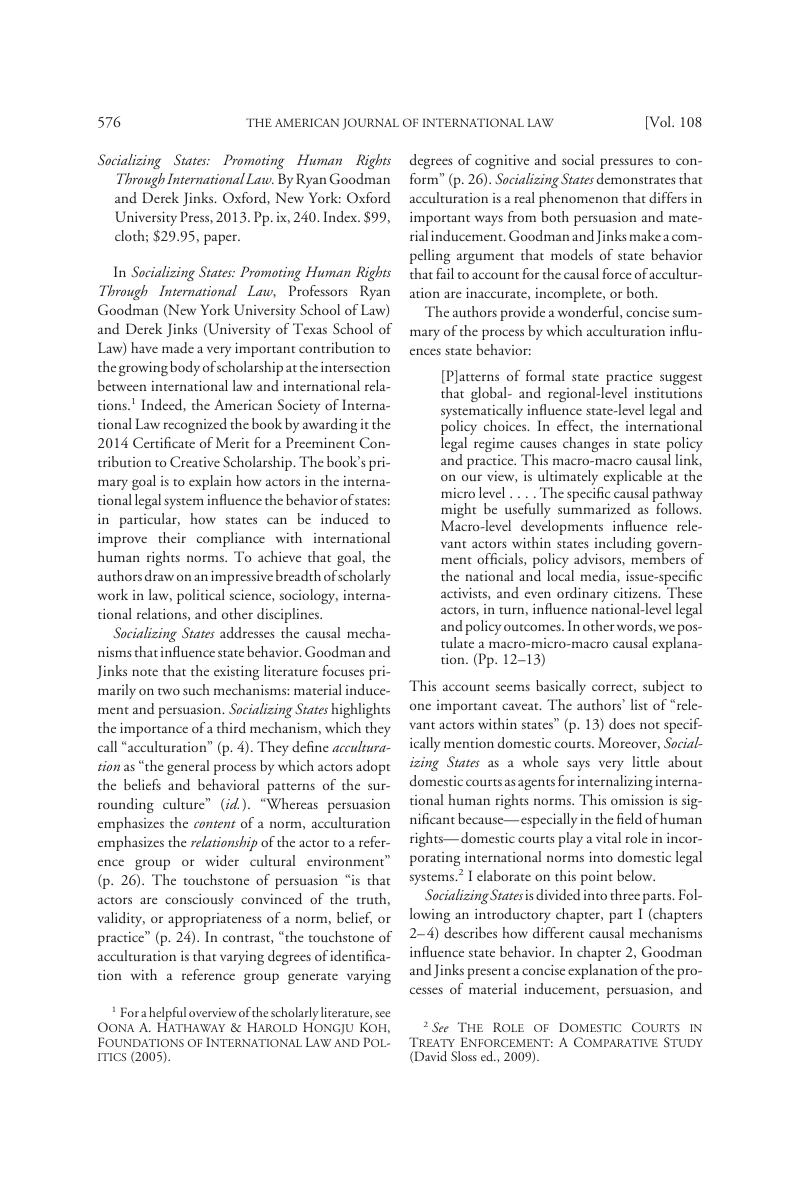Article contents
Socializing States: Promoting Human Rights Through International Law. By Ryan Goodman and Derek Jinks. Oxford, New York: Oxford University Press, 2013. Pp. ix, 240. Index. $99, cloth; $29.95, paper.
Published online by Cambridge University Press: 20 January 2017
Abstract

- Type
- Recent Books on International Law
- Information
- Copyright
- Copyright © American Society of International Law 2014
References
1 For a helpful overview of the scholarly literature, see Oona A. Hathaway & Harold Hongju Koh, Foundations of International Law and Politics (2005).
2 see The Role of Domestic Courts in Treaty Enforcement:A Comparative Study (David Sloss ed., 2009).
3 see Hathaway & Koh, supra note 1, at 1–3 (discussing the differences between norm-based and interest-based theories).
4 UN Charter, Art. 55(c) (emphasis added).
5 Universal Declaration of Human Rights, GA Res. 217A (III), UN Doc. A/810, at 71 (Dec. 10, 1948).
6 See, e.g., Fujii v. State, 242 P.2d 617 (Cal. 1952) (invalidating California’s Alien Land Law); Namba v. McCourt, 204 P.2d 569 (Or. 1949) (invalidating Oregon’s Alien Land Law).
7 See, e.g., Hurd v. Hodge, 334 U.S. 24 (1948) (holding that courts may not enforce racially restrictive covenants in the District of Columbia); Shelley v. Kraemer, 334 U.S. 1 (1948) (holding that state courts may not enforce racially restrictive covenants in Missouri and Michigan).
8 see Mary L. Dudziak, Cold War Civil Rights:Race and the Image of American Democracy (2000).
9 Letter from Acting Secretary Dean Acheson to the Fair Employment Practice Committee, May 8, 1946, quoted in To Secure These Rights, The Report of the President’s Committee on Civil Rights, at 146–47 (1947).
10 To Secure These Rights, supra note 9, at 100–01, 146–48.
11 see Dudziak, supra note 8.
12 see Carol Anderson, Eyes off the Prize: The United Nations and the African-American Struggle for Human Rights: 1944–1955, at 58–112 (2003).
13 see Lockwood, Bert B. Jr., The United Nations Charter and United States Civil Rights Litigation: 1946–1955, 69 Iowa L. Rev. 901 (1984)Google Scholar.
14 See, e.g., Brief for Petitioners, McGhee v. Sipes, 331 U.S. 804 (1947) (No. 1363), available at 1947 WL 44154 (listing Thurgood Marshall as counsel for the petitioners); Motion and Brief for the NAACP as Amicus Curiae Supporting Petitioners, Takahashi v. Fish & Game Comm’n, 334 U.S. 410 (1948) (No. 533),available at 1948 WL 47434 (listing Thurgood Marshall as counsel for the NAACP).
15 Quoted in Anderson, supra note 12, at 108 (emphasis added).
16 Brief for the United States as Amicus Curiae at 4–5, Shelley v. Kraemer, McGhee v. Sipes, 334 U.S. 1 (1948) (Nos. 72, 87) & Hurd v. Hodge, Urciolo v. Hodge, 334 U.S. 24 (1948) (Nos. 290, 291) (emphasis added), available at 1947 WL 44159.
17 Fujii v. California, 217 P.2d 481 (Cal. Ct. App. 1950),aff’d on other grounds, 242 P.2d 617 (Cal. 1952).
18 Id. at 488 (“Clearly such a discrimination against a people of one race is contrary both to the letter and to the spirit of the Charter which, as a treaty, is paramount to every law of every state in conflict with it.”).
19 See id. at 483–84. In contrast, the California Supreme Court rejected the UN Charter rationale but determined that the Alien Land Law violated the Fourteenth Amendment. Fujii, 242 P.2d at 622, 630.
20 see 96 Cong. Rec. S5993–6000 (1950).
21 Fairman, Charles, Finis to Fujii , 46 AJIL 682, 689 (1952)CrossRefGoogle Scholar.
22 Brown v. Bd. of Educ., 347 U.S. 483 (1954).
23 Bolling v. Sharpe, 347 U.S. 497 (1954).
24 Brief for Petitioners, Bolling v. Sharpe, 347 U.S. 497 (1954) (No. 8), available at 1952 WL 47257.
25 Brief for United States as Amicus Curiae Supporting Petitioners, Brown v. Bd. of Educ., 347 U.S. 483(1954) (No. 1) & Bolling v. Sharpe, 347 U.S. 497 (1954) (No. 8), available at 1952 WL 82045.
26 Fairman, supra note 21, at 689.
27 Plessy v. Ferguson, 163 U.S. 537 (1896).
28 Brown, 347 U.S. at 495; Bolling, 347 U.S. at 499–500.
29 see Duane Tananbaum, The Bricker Amendment Controversy:A Test of Eisen Hower’s Political Leadership (1988).
30 For a similar account of events preceding Brown, see Resnik, Judith, Law’s Migration: American Exceptionalism, Silent Dialogues, and Federalism’s Multiple Ports of Entry, 115 Yale L.J. 1564, 1598–606 (2006)CrossRefGoogle Scholar.
31 see Michael J. Klarman, From Jim Crow to Civil Rights:The Supreme Court and the Struggle for Racial Equality (2004).
- 1
- Cited by




